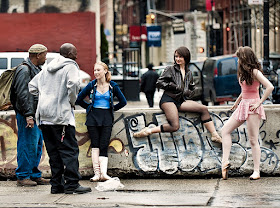50 street photos.
By the way, a few years ago I was a member of a street photography email discussion group, and I got shouted out of the room for suggesting that tele lenses were perfectly usable for street photography. Some of the less shy hardcore members held very strongly that only a wide-angle and getting right in people's faces was real street photography. Me, I don't see why one should limit oneself to certain technology just because Cartier-Bresson was limited to it in his heyday (a Leica is not practical with telelenses because the picture gets very small in the viewfinder).



I could be wrong (often am!), but I always thought that the 'essence' of 'street' photography was to be 'in amongst it', i.e. up close and personal, not physically removed from the event by the distance obtained with a terlephoto lens?
ReplyDeleteYes, that's probably how many people feel about it. I guess it's a viewpoint thing. For me, the end-all-be-all is the picture. For others, the subject is central.
ReplyDeleteI tend to agree with Philocalist. If you shoot tele, you're not on the scene yourself. Perhaps not even on the “street”.
ReplyDeleteI'm sure it is possible to get interesting pix this way. But I wouldn't call it street photography. More like spy photography. You are photographing individuals without confronting them, or in anyway making yourself part of the scene.
If you extend street photography to mean any shot of a street, it dilutes the concept. Paparazzis and private detectives would then also be “street photographers”.
I can see the viewpoint. But most street photographers working with wideangles also don't confront their victims, sorry, subjects. HC-B working like a ballet dancer, in, out, twirl around, nobody got a chance to notice him before he was gone. And Michal Daniel (640x480.net) works a lot with a palm pilot camera, so he gets right up in people's faces, but they don't see any camera. The pictures may *look* more like you're part of the scene, but you're still hiding what you're doing. At the very least most photographers prefer to get the shot before the subject notices them.
ReplyDeleteIt may show more personal bravery to stand closer to the subjects, but for the pictures, it doesn't matter to me. I'd say it only matters if you have been doing it and thinking about it, so you know how it feels different to do it this or that way. But that's a tiny percentage of the audience, I'd hope.
You didn't say how you define street photography then—if it is not necessary for the photographer to be part of the scene.
ReplyDeleteAre satellite images of The Times Square street photography? Why not?
Dear Eolake,
ReplyDeleteAre you forgetting the auxiliary finder that would attach to the shoe on the classic Leica rangefinder cameras like the
Leica IIIf? Didn't it zoom, or did it just have variable masking of the virtual image that the user viewed?
Yeah, as usual, therein lies the crux. "If you want to debate with me, you must define your terms". Problem is it takes time, and often leads to big, less relevant discussion.
ReplyDeleteI think that we could probably define Street Photography in five very different but all usable ways, which would lead to very different discussions.
Just for kicks: "people photographed in the streets and such public places".
Why would the photographer need to be part of the scene? He usually *isn't*, even when he is in the same space, unless he is part of a group being photographed. And then because he's the photographer, he's immediate less part of the group to that degree anyway.
This comment has been removed by the author.
ReplyDeleteThis comment has been removed by the author.
ReplyDeleteEolake wants to be able to do "street" photography from the comfort of his home. Having to go outside to do it is such a drag, man.
ReplyDeleteEolake wants to be able to do "street" photography from the comfort of his home.
ReplyDeleteThat's why I introduced satellite imagery to him for inclusion in his “street photographer's” arsenal. ;-)
It depends on how much tele it is, and on the angle. And on the feeling it gives.
ReplyDeleteI personally like lenses to be a little tele, wide angle distorts too much for me.
I guess there is something about the angle: you should be more or less at the same level than the people you are taking pictures of. So the photographer should be on the street.
> But most street photographers working with wideangles also don't confront their victims, sorry, subjects.
I think that's a good point.
The only downside to that site is the small size of the photos.
ReplyDelete